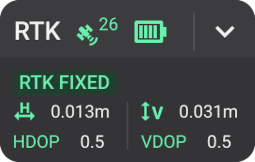How to interpret the Signal quality indicator dialog - PIX4Dcatch
When using a Pix4D supported RTK device with PIX4Dcatch, the RTK dialog displays the current strength, number of connected satellites, and expected accuracy of the RTK connection. Understanding this dialog can help inform when the device is ready for optimal capture and when reception and accuracy fluctuate, allowing for appropriate adjustments during capture.
IN THIS ARTICLE
Integrated GPS sensor
Pix4D supported RTK device via Bluetooth
Header
Accuracy
Status
Horizontal & Vertical Accuracy
Integrated GPS sensor

- GPS Status
Monitor the quality of cellular reception. 4 bars: Location accuracy less than 5m(16ft).
4 bars: Location accuracy less than 5m(16ft). 3 bars: Location accuracy between 5m(16ft) and 10m(33ft).
3 bars: Location accuracy between 5m(16ft) and 10m(33ft). 2 bars: Location accuracy between 10m(33ft) and 50m(164ft).
2 bars: Location accuracy between 10m(33ft) and 50m(164ft). 1 bar: Location accuracy greater than 50m(164ft).
1 bar: Location accuracy greater than 50m(164ft). No bars: No GPS signal.
No bars: No GPS signal.
 GPS Sensor / Bluetooth selection
GPS Sensor / Bluetooth selection
- Integrated GPS Sensor: Default selection using the internal GPS for geolocation.
- RTK via : Select when connecting Pix4D supported RTK device.
Pix4D supported RTK device via Bluetooth

Once the Pix4D supported RTK device is successfully connected to PIX4Dcatch, the RTK dialog will be visible. This screen displays information that can be used to monitor the status of the connection and the resulting accuracies.
Header
- The header contains the RTK connection icon, satellite connections, battery level, and access to the RTK connection dialog.
 The green RTK icon indicates the successful connection to the Pix4D supported RTK device.
The green RTK icon indicates the successful connection to the Pix4D supported RTK device.- 26 The number of satellites used in the RTK connection is indicated numerically. This number will vary in real-time.
 Battery level indicator.
Battery level indicator. The dropdown menu gives access to the RTK connection dialog.
The dropdown menu gives access to the RTK connection dialog.
- RTK vertical and horizontal accuracy estimations.
- Indicates the accuracy to which the Pix4D supported RTK device is expected to achieve. The unit of measurement is based on the mobile device's regional setting.
- HDOP and VDOP (Horizontal/Vertical Dilution of Precision).
- Indicates the current quality of the position and distribution of the satellites. Generally, the HDOP value is considered ideal below 1, while the VDOP value is considered ideal below 1.5.
- NTRIP RTK Status.
- Indicates the type of RTK NTRIP connection.
- RTK Fixed: Accuracy in the range of a few centimeters(in).
- RTK Float: Accuracy in the range of 1m(3ft)
- DGNSS Only: Accuracy in the range of up to 10m(32ft)
- Autonomous GNSS fix: Accuracy in the range of more than 10m(32ft)
- No Fix: The data is not valid, there are not enough satellites visible, or there are internet connection problems.
- Indicates the type of RTK NTRIP connection.
Accuracy
Indicates the expected accuracy for the current connection/status. After the RTK fix is established, the Horizontal Accuracy and Vertical Accuracy should be in the range of a few centimeters. In ideal conditions, the values are close to 0.01m/0.03ft.
- Blocked and reflected GNSS signal, close to buildings, trees, and/or bridges.
- Rapid movements of the device.
- Poor cellular reception.
- Maintain an upright antenna position for better performance.
Status
Once the Pix4D supported RTK device is successfully connected to PIX4Dcatch, wait for the RTK fix. For an optimal experience, ensure the antenna is not obstructed and you have a good internet connection.
Check the Status and the HDOP and VDOP during the acquisition to ensure optimal conditions. The status can fluctuate due to the visibility of available satellites. If RTK Fixed is lost, move slowly and deliberately to a point where RTK Fixed returns. Whenever possible, avoid overhead obstructions. PIX4Dcatch can adjust for the reduced reception once RTK Fixed returns.
Horizontal and Vertical Accuracy
The Horizontal Accuracy (H) increases (i.e. the value decreases) with the stability of the RTK signal. This value should be in the range of a few centimeters. In ideal conditions, the value should be close to 0.01m or 0.03ft.
The Vertical Accuracy (V) increases (i.e. the value decreases) with the stability of the RTK signal. This value should be in the range of a few centimeters. In ideal conditions, the value should be close to 0.01m or 0.03ft.
HDOP (Horizontal Dilution of Precision) and VDOP (Vertical Dilution of Precision) indicate the current quality of the position and distribution of the satellites.
Generally, the HDOP value is considered ideal below 1. To have centimeter-level accuracy, it has been observed that for the highest accuracies, we should take the readings with a value lower than 0.65.
Generally, the VDOP value is considered ideal below 1.5. To have centimeter-level accuracy, it has been observed that for the highest accuracies, we should take the readings with a value lower than 1.
